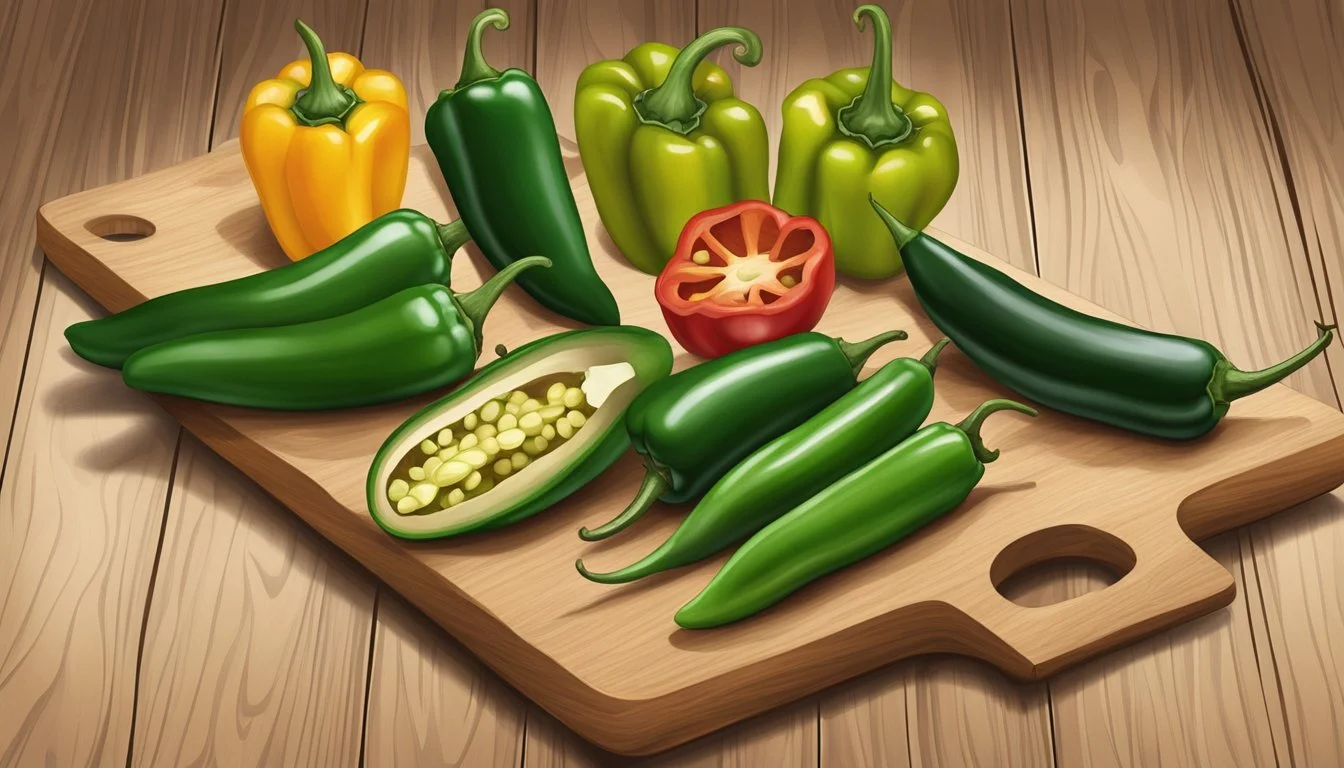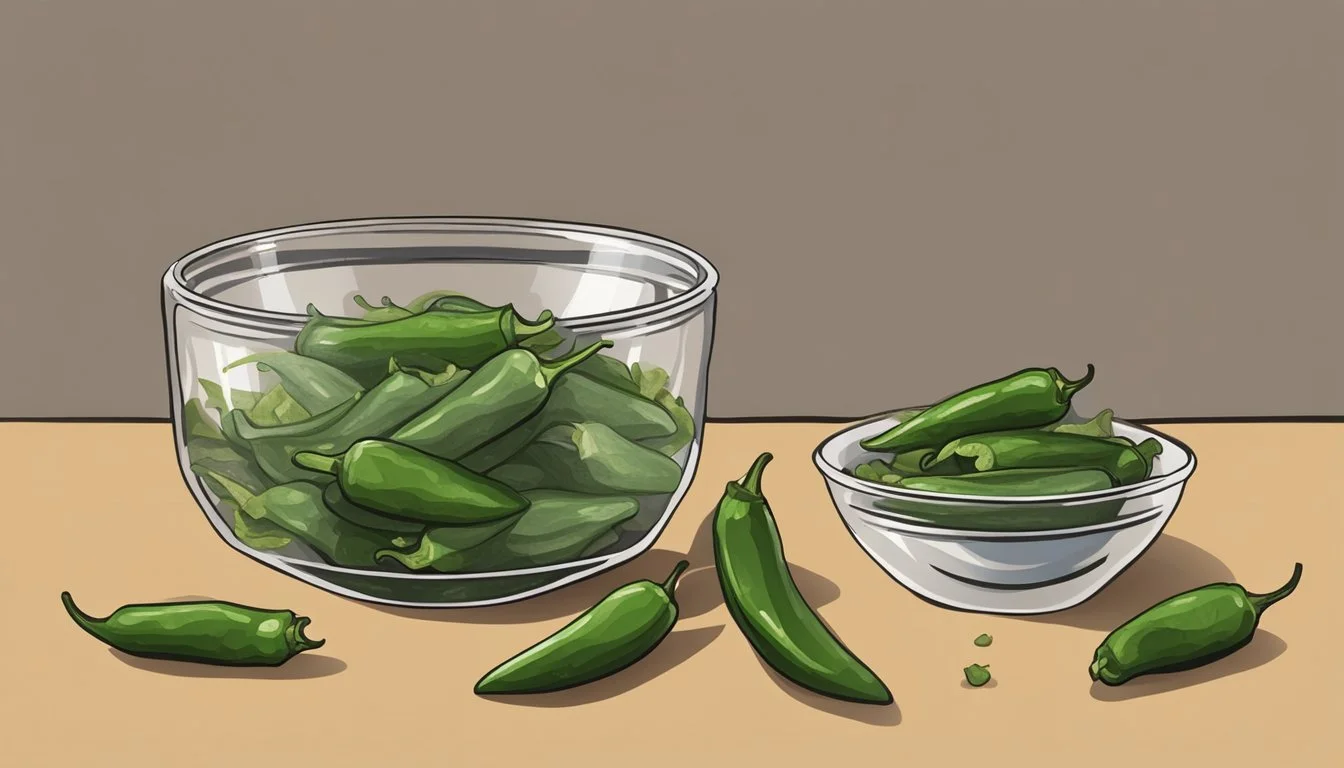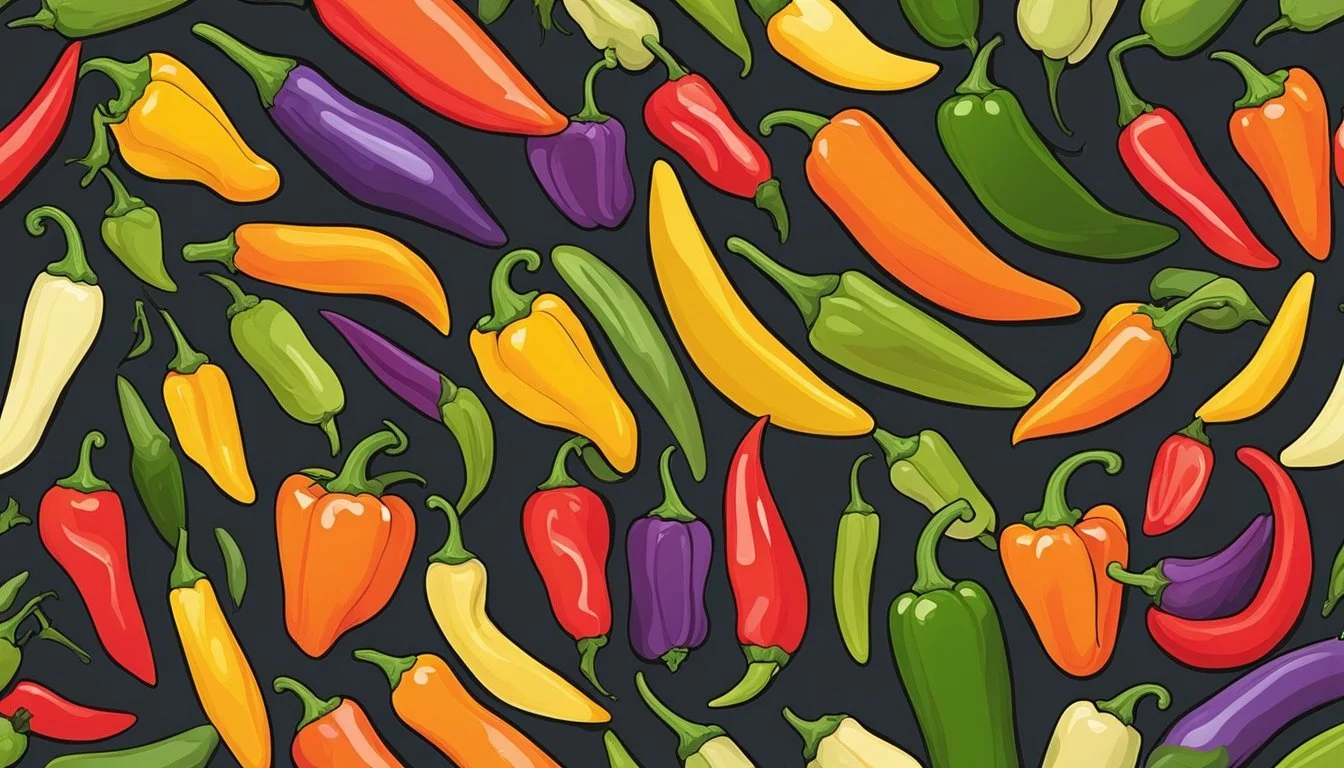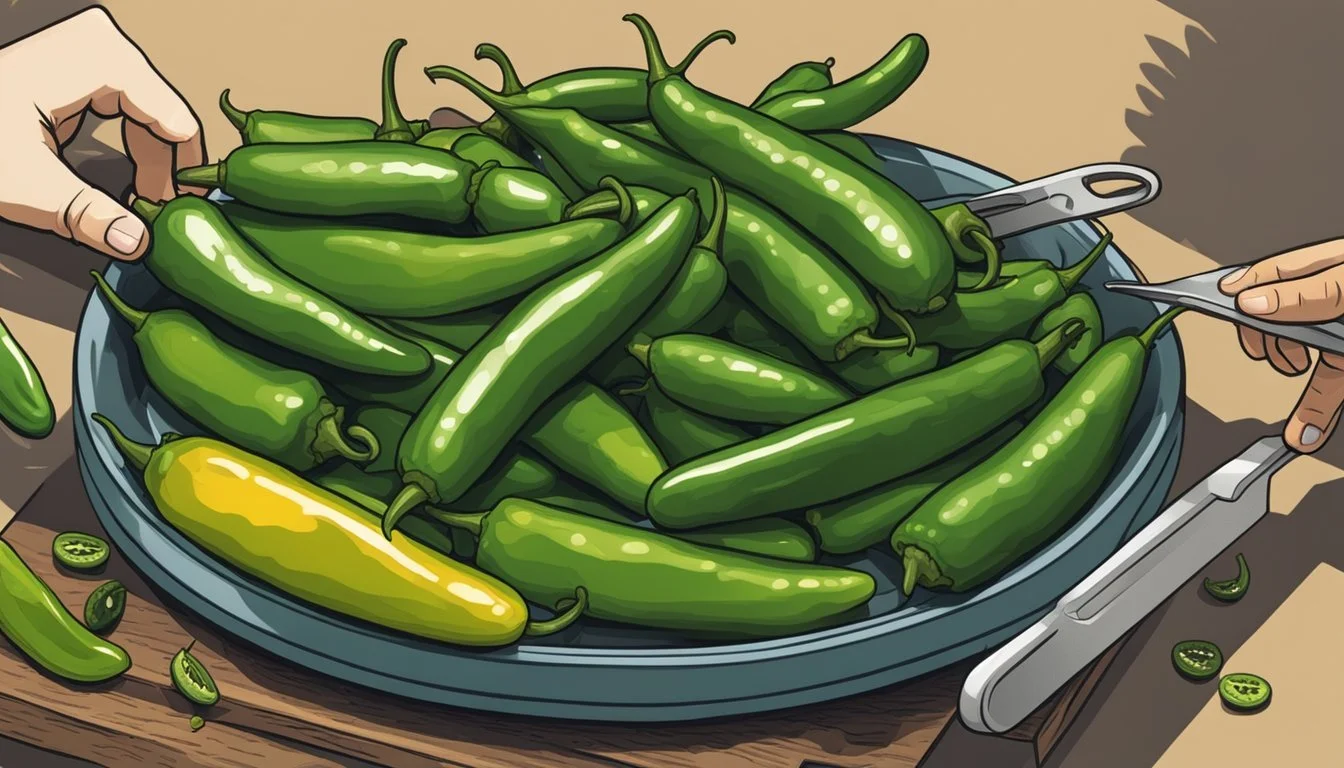Jalapeños Substitutes
Best Alternatives for Spicy Dishes
Jalapeños add a distinctive spice and flavor to many dishes, but sometimes, you may need a substitute. Whether you're looking to reduce the heat or simply can't find jalapeños at your local store, there are plenty of alternatives available. Cayenne pepper powder is a potent alternative that can spice up your dish significantly.
For those desiring a milder option, Anaheim peppers offer a pleasant heat and unique flavor without overwhelming your palate. If you're looking for something even milder with a touch of sweetness, pepperoncini could be your ideal choice. Each substitute can complement your recipes in different ways, making it easy to adjust the heat to your liking.
These substitutes cater to various heat preferences and flavor profiles, ensuring that your dishes remain flavorful even without jalapeños. Familiarize yourself with these options to confidently tweak your recipes and discover new favorite ingredients.
Understanding Jalapeños Characteristics
Jalapeños are known for their distinctive flavor, moderate heat level, and versatile texture. These characteristics make them a popular choice in various culinary applications.
Flavor Profile
Jalapeños have a crisp, bright flavor with a subtle earthiness. They offer a mild fruity taste, which is less pronounced than bell peppers but more discernible than spicier varieties like habaneros. Their fresh, grassy undertones add depth to dishes. When roasted or smoked, jalapeños develop a rich, smoky flavor, enhancing their versatility. These peppers are widely used in salsas, salads, and garnishes, providing a balanced complement to other ingredients.
Heat Level
On the Scoville Scale, jalapeños range from 2,500 to 8,000 Scoville Heat Units (SHU). This level of heat is considered moderate, making them accessible for those who are less tolerant of spice. While not as fiery as habaneros or cayenne peppers, they still pack a noticeable punch. The heat of a jalapeño is primarily concentrated in its seeds and inner membranes. Removing these parts can significantly reduce the spiciness, allowing for better control over the heat level in recipes.
Texture Variations
Jalapeños can be enjoyed in various textures depending on their preparation. Fresh jalapeños have a firm, crunchy texture, ideal for use in raw applications like salsas and garnishes. When cooked, they soften and become more pliable, making them suitable for stuffing or incorporation into cooked dishes. Roasting jalapeños changes their texture, creating a tender, almost creamy consistency with a slightly wrinkled skin. Pickled jalapeños, on the other hand, retain some crunch but acquire a tangy, acidic bite, perfect for adding to sandwiches and nachos.
Jalapeño Substitutes Overview
When choosing a jalapeño substitute, it's important to consider the heat level, flavor profile, and any potential dietary restrictions. Different substitutes can offer varied textures and taste experiences, so selecting the right one depends on the specific needs of the dish and the individual's preferences.
Criteria for Substitution
When substituting jalapeños, the Scoville heat unit (SHU) scale is essential to match the desired spiciness. Bell peppers have minimal heat and can be used for those who prefer very mild substitutes. In contrast, Cayenne pepper powder is significantly spicier, sitting around 50,000 SHU. It's ideal for recipes that can tolerate a higher spice level.
Flavor is another crucial factor. Some substitutes, like Anaheim peppers, provide a mild heat with a unique flavor that works well in a variety of dishes. Fresno peppers offer a similar heat level to jalapeños but with a slightly smokier and fruitier taste. Smoked paprika powder can add a rich, smoky flavor with mild heat, suitable for eggs, chili, or tacos.
Availability also plays a role. Some substitutes may be more readily available in certain regions, and hot sauces using jalapeños as a base, such as Yellowbird and Cholula Green Pepper Hot Sauce, can be convenient alternatives.
Considerations for Dietary Restrictions
Dietary restrictions must be taken into account when selecting jalapeño substitutes. For those dealing with allergies, it's crucial to ensure the substitute does not trigger any reactions. For example, those allergic to nightshades might need to avoid options like bell peppers and consider non-nightshade alternatives.
For specific dietary needs, such as vegan or gluten-free diets, choosing whole, unprocessed substitutes ensures compliance. Fresh peppers like Anaheims and Fresnos are typically safe choices, as are dried and powdered spices like smoked paprika.
When substituting in recipes for individuals with dietary restrictions, always check ingredient labels on commercially prepared products like hot sauces to confirm there are no hidden allergens or unwanted additives.
Fresh Pepper Alternatives
Choosing the right fresh pepper substitute for jalapeños depends on your desired heat level and flavor profile. Below are various options, with details on each pepper's characteristics, heat level, and suitable culinary uses.
Serrano Peppers
Serrano peppers are a common alternative to jalapeños, offering a similar flavor but with more heat. They range from 10,000 to 23,000 Scoville Heat Units (SHU).
Serranos are smaller and thinner, making them great for salsas, guacamoles, and hot sauces. They can be used fresh or roasted, and their bright, intense flavor adds a strong kick to dishes. Substitute jalapeños with serranos measure-for-measure, adjusting for heat as needed.
Fresno Peppers
Fresno peppers closely resemble jalapeños in both appearance and heat level, though they tend to be slightly milder, ranging from 2,500 to 10,000 SHU.
They have a slightly fruitier flavor, ideal for salsas, salads, and pickling. Fresnos are often used as a topping for burgers and tacos. When substituting for jalapeños, Fresnos offer a balanced heat and sweetness that complements a variety of dishes.
Anaheim Peppers
Anaheim peppers are much milder than jalapeños, with a SHU ranging from 500 to 2,500. They have a sweet, slightly tangy flavor and are typically larger and longer.
Anaheims are excellent for stuffing, roasting, and grilling. They are often used in Southwestern and Mexican dishes like chile rellenos. When replacing jalapeños with Anaheims, consider adding other spices or peppers to maintain the desired heat level.
Poblano Peppers
Poblano peppers are another mild substitute, with a SHU range of 1,000 to 2,000. They are larger and darker green compared to jalapeños, with a rich, earthy flavor.
Poblanos are perfect for stuffing, grilling, or making traditional Mexican dishes such as chiles en nogada. Their thick walls and mild heat make them versatile in both raw and cooked applications. Use them in recipes where a richer, less intense pepper flavor is desired.
Bell Peppers
Bell peppers are the mildest option, as they have a SHU of 0. They come in various colors—green, red, yellow, and orange—and offer a sweet, crisp flavor.
Bells are best used when you need to replicate the texture without the heat. They work well in salads, stir-fries, and stuffed pepper dishes. When substituting bell peppers for jalapeños, the dish will lack spiciness, so adding hot sauce or another spicy element may be necessary for balance.
Banana Peppers
Banana peppers offer a mild to moderate heat level, with a SHU of 100 to 500. They have a tangy, slightly sweet flavor, making them suitable for fresh salsas, salads, and pickling.
Banana peppers are often used as toppings for pizzas and sandwiches. Their mild heat and distinctive flavor can be a refreshing change from jalapeños in various dishes. Adjust the amount based on the desired spiciness.
Shishito Peppers
Shishito peppers are an occasional wild card in terms of heat. Most are mild, ranging from 100 to 1,000 SHU, but one in ten can be moderately spicy.
These thin-walled, wrinkled green peppers are typically pan-fried or roasted until blistered, then served as appetizers. Their mild, slightly sweet flavor and occasional heat make them an intriguing substitute for jalapeños in recipes that allow for some unpredictability in spice.
Substitutes in Cooked Dishes
Working with jalapeño substitutes in cooked dishes requires selecting the right alternative for each specific recipe. Whether you're preparing salsas, stuffed peppers, or tacos, choosing the best replacement ensures the flavor, heat, and texture are preserved. Here are some ideal substitutes for various cooked dishes:
For Salsas and Mexican Cuisine
Poblanos are a suitable choice for salsas and other Mexican dishes. These peppers offer a mild heat and a rich, earthy flavor that blends well with tomatoes, onions, and cilantro in salsa.
Anaheim peppers are also a versatile substitute, providing a slightly sweet taste with minimal spiciness. These work well in guacamole, pico de gallo, and quesadillas.
For those seeking more heat, serrano peppers deliver a sharper spice than jalapeños, perfect for salsas where a more intense flavor is desired.
For Stuffed Pepper Recipes
In stuffed pepper recipes, poblanos again make an excellent substitute due to their larger size and mild flavor. They can be stuffed with meats, rice, or vegetables, offering a satisfying meal without too much heat.
Bell peppers are another great option for those who prefer no heat at all. They provide a substantial cavity for stuffing and their sweet taste complements a variety of fillings.
For an adventurous twist, consider using banana peppers. They offer a tangy, mildly spicy flavor that works well in recipes calling for stuffed jalapeños, adding a unique taste to the dish.
For Tacos and Nachos
Tacos and nachos benefit immensely from the inclusion of flavorful peppers. Serranos can be diced and added for those who enjoy a spicier bite, while Anaheim peppers offer a milder, sweeter alternative.
Chipotle peppers in adobo sauce can add a smoky depth to these dishes, enhancing the overall flavor profile without overpowering the other ingredients.
Fresno peppers, with their bright color and moderate heat, also serve as a suitable replacement, ensuring that these popular dishes remain both colorful and flavorful.
Alternative Flavors in Cooking
For recipes where alternative flavors are desired, habaneros introduce a fruity, intense heat but should be used sparingly due to their high spice level.
Cherry peppers offer a sweet and tangy flavor, making them a good option for more subtle heat and a delightful taste.
In salads, sandwiches, and non-traditional Mexican dishes, pepperoncini peppers provide a mild, tangy taste that enhances the overall dish without adding significant heat.
Using these substitutes allows for flexibility in cooking while ensuring the desired flavors and heat levels are achieved, maintaining the integrity of the recipes.
Dried and Powdered Substitutes
When fresh jalapeños are not available, dried and powdered alternatives can provide the desired heat and flavor variations in dishes. These substitutes range from mild to extremely spicy, catering to different taste preferences.
Cayenne Pepper Powder
Cayenne pepper powder is a go-to substitute for those seeking a spicier alternative to jalapeños. It has a Scoville Heat Unit (SHU) rating of around 50,000, making it significantly hotter. This powder can be easily incorporated into recipes, such as stews, soups, and sauces. Because of its intense heat, it's advisable to start with small amounts, usually one-quarter to one-half teaspoon, and adjust according to taste. Important note: Always handle cayenne pepper with care to avoid irritation.
Smoked Paprika Powder
Smoked paprika powder offers a milder heat compared to cayenne pepper but provides a rich, smoky flavor. This makes it an excellent option for dishes like eggs, chilies, and tacos that benefit from both color and flavor. Measurement guidance: Typically, one teaspoon of smoked paprika can replace 2-3 jalapeños. It enhances the dish without overpowering it, delivering a subtle and balanced spice.
Chipotle Peppers
Chipotle peppers are smoked, dried jalapeños, making them a natural substitute. They pack a moderate heat and deep smoky flavors, ideal for barbecue sauces, marinades, and Mexican cuisine. Available in whole dried form or as a powder, they can be soaked in hot water before use or added directly in powdered form. Pro tip: Using powdered chipotle peppers is convenient, allowing for precise control over consistency and heat level in recipes.
Pickled and Canned Alternatives
Finding substitutes for jalapeños can be essential for replicating their blend of heat and tang. Pickled and canned options offer convenience and distinct flavors.
Pepperoncini as an Alternative
Pepperoncini are mild, tangy peppers that serve as an effective stand-in for jalapeños. They have a lower heat level but bring a similar crunch and vinegar touch, making them suitable for salads, sandwiches, or even pizzas. The acidity of pickled pepperoncini can enhance dishes that benefit from a milder spice while still retaining a similar texture to jalapeños. This pepper is readily available in pickled form, adding a reliable tang to your recipes.
Canned Green Chilies
Canned green chilies provide a mild heat, making them a versatile substitute for jalapeños. These chilies can easily blend into soups, stews, and casseroles, offering a subtle warmth without overwhelming the dish. They are pre-roasted and peeled, minimizing preparation time. The texture of canned green chilies is softer than fresh jalapeños, but they still contribute a satisfying bite. Their canned form ensures a consistent flavor, which can help stabilize your recipes.
Pickled Banana Peppers
Pickled banana peppers are an excellent alternative, providing a mix of mild heat and sourness. They are less spicy than jalapeños but retain a similar crunch, making them suitable for toppings on burgers, nachos, and more. The pickling process imparts a distinctive tang from vinegar, complementing various dishes. These peppers are also available in sweet and spicy versions, allowing flexibility depending on the heat level desired. Their vibrant color adds an appealing visual element to your meals.
Considerations for Heat and Flavor Balance
Selecting the right substitute for jalapeños involves balancing heat levels and flavor profiles. This ensures that the substituted pepper aligns well with the intended taste and spiciness of the dish.
Adjusting for Heat Levels
When replacing jalapeños, understanding the spice level of the substitute is crucial. Jalapeños typically range from 2,500 to 8,000 Scoville Heat Units (SHU). Serrano peppers, for example, are significantly hotter, with 10,000 to 23,000 SHU. To achieve a similar heat, you might use half to two-thirds the amount of serrano.
On the other hand, Anaheim peppers offer a milder alternative, boasting a range of 500 to 2,500 SHU. They provide a milder, same flavor option, ideal for those who prefer a gentler heat. Using the right amount is key to maintaining the desired spiciness.
Understanding Flavor Impact
The flavor of the substitute can significantly alter the dish's taste. Jalapeños have an earthy flavor with a slightly smoky aroma. If a fruitier flavor is preferred, habanero peppers are a suitable choice, although they are much hotter.
Anaheim peppers offer a mild and sweet taste, which can be a good alternative for those looking for a less tangy flavor. Hot sauces such as Cholula Green Pepper Hot Sauce, which use jalapeños as a base, can also maintain the heat and provide a similar earthy flavor with added tanginess.
Choosing a substitute that complements the other ingredients ensures that the dish's overall flavor profile remains balanced and enjoyable.
Substitution Techniques and Tips
Choosing the right jalapeño substitute requires attention to the quantity, texture, and variability of peppers to achieve desired flavors and heat levels.
Measuring the Right Quantity
When replacing jalapeños, accurate measurement is essential. Bell peppers and smoked paprika powder may be used for milder options. For instance, use 1 teaspoon of smoked paprika powder as a substitute for every 2-3 jalapeños. Cayenne pepper powder and habanero peppers can replace jalapeños when more heat is desired. Since cayenne is significantly hotter, a small quantity, such as a pinch, can often suffice. Measuring the precise equivalent helps maintain balance in your dish’s flavor profile.
Texture Considerations in Substitutes
Texture influences the overall mouthfeel and presentation of a dish. Jalapeños have a specific crunch that bell peppers and poblano peppers can mimic well due to their thick skin and firm structure. Serrano peppers, with their thinner walls and similar crunch, are excellent one-to-one replacements. For sauces, where texture is less critical, jalapeño-based hot sauces or cayenne pepper powder can be suitable alternatives. Always consider the raw or cooked state of substitutes to align with the desired texture in the recipe.
Dealing with Pepper Variability
Peppers can vary widely in heat and flavor. Capsaicin levels determine spiciness, which is higher in peppers like habaneros and cayenne peppers compared to jalapeños. It's important to taste test and adjust quantities accordingly. Using bell peppers or smoked paprika powder helps control heat levels while providing a similar flavor base. Supermarket availability may also influence choices, with common substitutes like bell peppers and poblanos often being more accessible. Factoring in the variability ensures the chosen substitute matches the specific need of the dish.
Safety and Handling
When working with jalapeños or their substitutes, it's crucial to handle them properly and be aware of potential heat levels that can affect your dish and overall safety.
Handling Spicy Peppers
Spicy peppers, including jalapeños and their substitutes like serrano or cayenne, contain capsaicin, which is responsible for their heat. Capsaicin can irritate skin and eyes, so it is advisable to wear gloves when handling these peppers.
Avoid touching your face, especially eyes, after handling peppers. Wash hands thoroughly with soap and water. When cutting, use a sharp knife to minimize juice splatters. Dispose of seeds properly if you want to control the heat level.
Substitution Caution
Substituting jalapeños with other peppers requires careful consideration. Heat levels, measured in Scoville Heat Units (SHU), vary greatly. For example, cayenne pepper powder is around 50,000 SHU, significantly hotter than jalapeños, which range from 2,500 to 8,000 SHU.
Start with a smaller amount and adjust to taste, especially for those who may be sensitive to spiciness. Always introduce substitutes gradually to manage the kick of heat effectively without overwhelming your dish.










